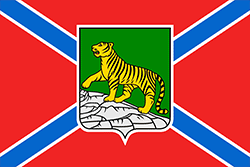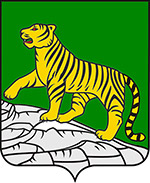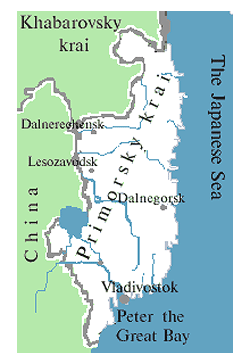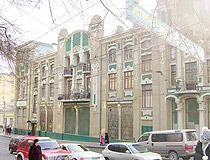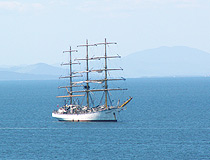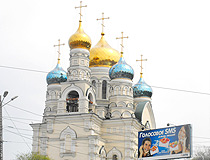History of Vladivostok
Foundation of Vladivostok
In the distant past, the territory of today’s Vladivostok was part of the multi-ethnic kingdom of Balhae (698-926). At the beginning of the 13th century, on the territory of Primorye, there were several towns of the Jurchen kingdom of Eastern Xia. All of them were destroyed by the Mongols as a result of the attack of 1233, after which the territory fell into desolation.
From the standpoint of official Russian historiography, until the appearance of the Russian pioneers, this region remained untouched and forgotten, which was partly facilitated by the policy of self-isolation pursued in China and Korea in the 17th-19th centuries. However, this is not confirmed by the testimonies of the Russian pioneers themselves. For example, Erofei Khabarov (1603-1671) in his letters reported that “this land cannot be taken over, because it is crowded and the fighting is fierce.”
In the first half of the 19th century, Okhotsk, Ayan, Petropavlovsk-Kamchatsky, Nikolaevsk-on-Amur alternately played the role of a stronghold of the Russian Empire in the Far East. However, none of these ports met the necessary requirement - to have a convenient and protected harbor, next to trade routes.
After the conclusion of the Aigun Treaty (1858), the Russians began to actively explore the Amur region, and as a result of the signing of the Tianjin (1858) and Peking (1860) treatises, the territory of today’s Primorsky Krai and Vladivostok was annexed to the Russian Empire.
In the summer of 1860, the first Russian military unit arrived in the Golden Horn Bay to establish a military post, which officially received the name of Vladivostok (“The Ruler of the East”), by analogy with the city of Vladikavkaz (“The Ruler of the Caucasus”).
More Historical Facts…
Vladivostok in the late 19th - early 20th centuries
A few years after its foundation, Vladivostok became the main port of the Russian Empire in the Far East. In 1871, the main naval base of the Siberian military flotilla, the headquarters of the military governor and other naval departments were transferred to Vladivostok from Nikolaevsk-on-Amur. According to the first census of 1878, there were 8,393 residents in Vladivostok, of whom 4,952 were Russians and 3,441 - foreigners. In 1880, Vladivostok officially received the status of a town.
In the 1890s, a demographic and economic boom took place in Vladivostok after the completion of the construction of the Ussuriysk branch of the Trans-Siberian Railway and the Chinese-Eastern Railway. According to the first census of the population of the Russian Empire of 1897, 28,993 people lived in Vladivostok. Ten years later, the city’s population tripled.
During the Russo-Japanese War (1904-1905), Vladivostok was shelled from the sea by Japanese ships. However, a detachment of cruisers based in the harbor of Vladivostok remained the only combat-ready formation of the Russian fleet in the Far East until the end of the war.
The first decade of the 20th century was characterized by a prolonged crisis in the development of Vladivostok, caused by a number of reasons: change of government focus to Port Arthur (today’s Dalian in China), the Boxer Rebellion in North China (1900-1901), the Russo-Japanese War (1904-1905), and finally the first Russian revolution (1905-1907).
A new stage in the development of Vladivostok began in 1907. The loss of Port Arthur again made Vladivostok the main port of the Russian Empire in the Pacific Ocean. Until 1914 (before the First World War), the city experienced rapid growth and became one of the economic centers of the Asia-Pacific region. The population of Vladivostok exceeded 100 thousand people. There were large Chinese, Korean and Japanese communities in the city.
During the First World War, Vladivostok was an important center for the import from allied and neutral countries of military-technical equipment for the Russian troops, as well as raw materials and equipment for industry.
Vladivostok from 1917 to World War II
On October 30, 1917, the sailors of the Siberian Flotilla decided to “rally around the united power of the Soviets” - power in the city passed to the Bolsheviks. However, on June 29, 1918, Czechoslovak troops (the Czechoslovak Legion) overthrew Soviet power in Vladivostok. In the fall of 1918, the troops of the United States, Japan, Italy, and Canada entered the city. Throughout 1919, the region was engulfed in a partisan war.
In order to avoid a war with Japan, at the suggestion of the Soviet leadership, the Far Eastern Soviet Republic, a nominally independent state, was proclaimed on April 6, 1920. Most of the foreign troops left Vladivostok in 1920, apart from the Japanese forces. Diplomatic pressure, as well as domestic protests and huge expenses incurred by the Siberian Expedition, forced Japan to withdraw its troops from Primorye in October 1922. In November, 1922, the Far Eastern Soviet Republic was liquidated and became part of the Russian Soviet Federative Socialist Republic.
Vladivostok was in decline, the city’s population decreased to 106 thousand people. In 1923-1925, the Soviet government adopted a restoration plan, during which the commercial port resumed operation. The Far East avoided the period of war communism, destructive for the country’s economy, and immediately found itself in the situation of the New Economic Policy, which allowed, to a certain extent, a free market.
In the 1930s-1940s, Vladivostok was used as a transit point for prisoners and cargo for “Sevvostlag” (North-Eastern Corrective Labor Camps) of “Dalstroy” (Far North Construction Trust). The Vladivostok transit camp, where prisoners were brought from all over the Soviet Union, was located in the city. The poet Osip Mandelstam died here. The following famous people passed through it: future actor Georgy Zhzhonov, writers Varlam Shalamov and Yevgenia Ginzburg, academician Sergei Korolev, and hundreds of thousands of other political prisoners.
In 1939, the population of Vladivostok was about 206,000 people. During World War II, Vladivostok was the largest Lend-Lease center, handling imported cargo almost 4 times more than Murmansk and almost 5 times more than the Arkhangelsk group of ports.
Vladivostok after World War II
On August 11, 1951, a special regime was introduced in Vladivostok - the city became closed to foreigners. During the years of the Khrushchev Thaw, Vladivostok received special attention from the state authorities. For the first time, Nikita Khrushchev visited the city in 1954. It was noted that at that time the city infrastructure was in poor condition.
In 1959, after visiting the United States, Nikita Khrushchev again visited Vladivostok. Impressed by his visit to the US, Khrushchev put forward a slogan to make Vladivostok a better city than San Francisco. The result of this visit was the active housing construction of the 1960s, known among local residents as “Big Vladivostok”. In particular, a funicular and avenue of the 100th anniversary of Vladivostok were built. In 1968, the population of Vladivostok exceeded 400 thousand people.
In 1974, the 38th President of the United States, Gerald Ford, paid an official visit to Vladivostok to meet with Leonid Brezhnev, the General Secretary of the CPSU Central Committee. At the meeting, the sides signed a protocol to the Anti-Ballistic Missile Treaty and the Treaty on the Limitation of Underground Nuclear Testing, which helped curb the arms race. In 1989, the population of the city was about 633 thousand people.
On September 20, 1991, Boris Yeltsin, the President of the Russian Soviet Federative Socialist Republic, signed a decree on the opening of Vladivostok for visiting by foreign citizens - Vladivostok ceased to be a closed city.
The collapse of the USSR greatly influenced the city’s economy. State defense enterprises were deprived of orders, which led to an increase in unemployment. The surviving fishing enterprises mainly switched to the export of fish and seafood to Japan. In the 1990s, Vladivostok became a center for illegal fishing, timber smuggling, and the resale of Japanese cars.
Due to the decline in living standards, the birth rate fell and migration to the European regions of Russia increased. However, Vladivostok retained the status of an important transport, industrial, commercial, and financial center of the region.
At the beginning of the 21st century, there was an improvement in the social and economic situation. On November 4, 2010, Vladivostok was awarded the title “City of Military Glory”. In September 2012, the APEC summit was held on Russky Island in Vladivostok. To prepare for it, about $ 20 billion was invested in the development of the city’s infrastructure. The main construction projects were a bridge across the Golden Horn Bay and a bridge to Russky Island, a new international airport, and the Far Eastern Federal University.
December 13, 2018, Vladivostok became the administrative center of the Far Eastern Federal District.
General views of Vladivostok
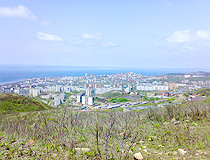
General view of Vladivostok
Author: Nikolay Kundyshev
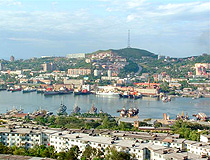
Zolotoy Rog Bay in Vladivostok
Author: Alexey Yefremov
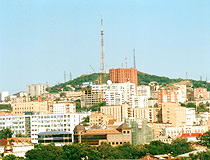
Vladivostok cityscape
Author: Melnikov Vladimir
Vladivostok - Features
Vladivostok is located on the Muravyov-Amursky Peninsula and islands in the Peter the Great Bay of the Sea of Japan. The last station of the Trans-Siberian Railway, it is one of the largest seaports in the region and the main base of the Russian Pacific Fleet. The distance from Vladivostok to Moscow by rail is 9,288 kilometers, by highway - 9,024 km. The distances to other, closer capital cities: Seoul (South Korea) - 750 km, Tokyo (Japan) - 1,060 km, Beijing (China) - 1,340 km.
“Vladivostok” literally means “The Ruler of the East”, named by analogy with the Russian city of Vladikavkaz (“The Ruler of the Caucasus”). This city is also known as “The Pacific Gate of Russia” and “The Fishing Capital of Russia”. The coat of arms of Vladivostok, which repeats the historical coat of arms adopted in 1881, depicts the Amur tiger. Vladivostok City Day is celebrated in early July.
The city has a moderate monsoon climate. The climatic conditions of Vladivostok are among the most favorable in the Russian Far East. The winter period (November-March) is characterized by frosty, dry and clear weather. The calendar summer in Vladivostok is divided into two clearly separated periods. The first half is characterized by cool and cloudy weather, with drizzling rains and fog. The second half is characterized by warm weather with prevailing southeast winds. In summer, typhoons with heavy rains are typical. The average temperature in January is minus 12.3 degrees Celsius, in August - plus 19.8 degrees Celsius.
Vladivostok is a large economic center of the Far East with a diversified economy represented by developed manufacturing industries (mechanical engineering, shipbuilding, ship repair, food production, etc.), wholesale and retail trade, services, transport, and communications.
Its cargo and passenger port is a link between the Trans-Siberian Railway and the Pacific sea routes. The main export items are fish and seafood, timber, ferrous and non-ferrous metals. The main items of import are foodstuffs, medicines, clothing, footwear, household appliances, and used cars.
Vladivostok International Airport, one of the largest in the Far East, offers regular flights to Krasnoyarsk, Irkutsk, Novosibirsk, Moscow, Khabarovsk, Petropavlovsk-Kamchatsky, Yuzhno-Sakhalinsk, Krasnodar, and a number of other cities.
The federal highway A370 “Ussuri” connects the city with Khabarovsk. Vladivostok is the most motorized city in Russia per capita due to the availability of cheap used cars from Japan. The main type of public transport in Vladivostok are buses. There are also trolleybuses, trams, a funicular, sea boats, and ferries.
The Far Eastern Federal University and the Far Eastern Branch of the Russian Academy of Sciences make Vladivostok the largest scientific and educational center of the Russian Far East. Vladivostok is also the cultural center of Primorsky Krai. Dozens of cultural institutions are open in the city - museums, theaters, art galleries, movie theaters, and a philharmonic society.
Vladivostok is the closest city to the countries of the Asia-Pacific region with European culture, cuisine, and architectural tradition, which makes it attractive to tourists (about 500 architectural monuments and more than 100 fortifications of the Vladivostok fortress). The city center has preserved the historical ensemble of the turn of the 19th-20th centuries. Here you can see all the styles that were presented at that time - from the neoclassicism of the late 19th century and various directions of Art Nouveau, to the neoclassicism of the 1930s-1950s.
Besides cultural tourism, this city is a center of sea and recreational tourism. Tourists are also attracted to Vladivostok by the gambling zone “Primorye”. Most of the tourists come from China, the Republic of Korea, and Japan.
Main Attractions of Vladivostok
Cable-stayed bridges of Vladivostok. The idea to connect the districts of Vladivostok, separated by the Golden Horn (Zolotoy Rog) Bay and the Eastern Bosphorus Strait, appeared already in the second half of the 19th century. The First World War postponed these plans for an indefinite future. Then the Second World War prevented them. Finally, the decision to construct these cable-stayed bridges was made in the 2000s. Both bridges were built in 2012 - for the APEC summit in Vladivostok.
The Golden Bridge (across the Golden Horn Bay) is located in the very center of Vladivostok. It connects the city with remote districts and the federal highway. It has sidewalks for pedestrians, so here you can enjoy the beautiful views of the bay and the city. The length of the bridge is about 1,400 meters.
The Russky (Russian) Bridge (3,100 meters) connects the Nazimov Peninsula and the Novosilsky Cape on Russky (Russian) Island. The most beautiful views of this bridge can be seen from Orlinoye Gnezdo (Eagle’s Nest) hill, especially in the evening. This bridge is depicted on a 2,000 ruble note.
Tours along the cable-stayed bridges of Vladivostok is a popular entertainment for tourists, walks on both bridges are often included in sightseeing tours of the city. Groups usually leave from the center of Vladivostok to Russky Island, the duration of excursions is from 3 to 6 hours. Sea excursions depart daily from April to October from berth #30 (Marine Passenger Terminal for Coastal Communications, Nizhneportovaya Street, 1d).
Russky Island. This island is located in the Peter the Great Bay of the Sea of Japan south of Vladivostok. Here you can find the campus of the Far Eastern Federal University, a promenade, a huge Primorsky Oceanarium, fortifications of the Vladivostok fortress (primarily the Voroshilov battery). But its main attraction is pristine nature, stunning views of the rocky shores and the ocean. In summer you can swim here.
Orlinoye Gnezdo (Eagle’s Nest) observation deck - the highest hill (sopka) in the central part of Vladivostok (199 meters above sea level). At its foot there is an observation deck from where you can take great photos of the Golden Bridge. Here you can admire the picturesque city panorama, ships and sea views. You can get to this site on foot, by public transport or by funicular. This is one of the most visited places in Vladivostok.
The Vladivostok funicular - the only funicular in Russia that operates as public transport. It appeared in Vladivostok on the initiative of Nikita Khrushchev in 1962. After his visit to the United States, he decided to make Vladivostok the second San Francisco. Vsevolod Sibirev Street (upper station); Pushkinskaya Street, 29 (lower station).
Tsarevich Nicholas Triumphal Arch. It was erected in honor of the visit of the future Emperor Nicholas II to Vladivostok in 1891. The structure is an elegant brick and stone arch made in the Russian-Byzantine style. In the upper part there is an image of the patron saint of sailors, Nicholas the Wonderworker. The original arch was blown up as a symbol of tsarism in 1930. In 2003, the Triumphal Arch was rebuilt. Peter the Great Street, 6.
Cathedral of the Intercession of the Mother of God - the main Orthodox church in Vladivostok built in 1902 and destroyed in 1935. In Soviet times, a park was located in its place. A complete copy of the cathedral was erected on the old foundation in 2007. Okeanskiy Avenue, 44.
Pictures of Vladivostok
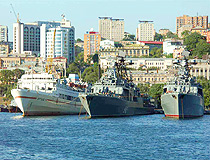
Military ships in Vladivostok
Author: Max Palchevsky
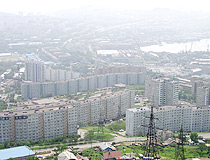
Apartment buildings in Vladivostok
Author: Nikolay Vyatkin
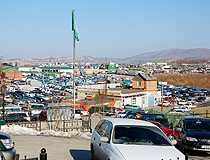
Car market in Vladivostok
Author: Viktor Biryuk
Evangelical Lutheran Church of St. Paul - a Protestant church of the early 20th century, a monument to North German Gothic, the oldest religious building in Vladivostok. After 1917, it housed a movie theater and a club, later - the Pacific Fleet Museum. In 1997, the building was returned to the believers. Today, it is one of the most important cultural centers of Vladivostok. In addition to church services, organ music concerts and charity events are held here. Pushkinskaya Street, 14.
Catholic Church of Mother of God. For a long time, this Catholic church built in the neo-Gothic style was considered the largest in the Asian part of Russia. The main construction phase was completed in 1921. Closed in 1935, it was used as the State Archives of Primorsky Krai until 1991. In 2010, the reconstruction of the building was completed. Organ music concerts are also held here. Volodarsky Street, 22.
Military History Museum of the Pacific Fleet. This museum is known for its unique exhibits, which are presented in 11 halls. The Russo-Japanese War, the Russian Civil War, the Second World War - the expositions tell in detail about these events, as well as about the post-war period. The exposition is complemented by landscapes of local marine painters and models of warships. There is also an exhibition of military equipment located in the courtyard of the museum. Svetlanskaya Street, 66.
Vladimir K. Arseniev Museum of Far East History - a local history museum with the largest exposition in Primorsky Krai. Here you can see natural, archaeological and ethnographic collections, as well as exhibits about the explorers of this region. Svetlanskaya Street, 20.
Primorsky State Art Gallery. The permanent exhibition is housed in nine halls and presents more than 150 works of Old Russian, Russian and Western European art - works of Italian, French, Dutch artists. Old Russian art is represented by icons of the 16th - 19th centuries. Aleutskaya Street, 12.
Antique Automobiles Museum. The exposition of this museum consists of rare motorcycles and cars produced in different countries. In total, there are several dozen vehicles in six halls. Among them there are Japanese and German vehicles obtained as war trophies, Soviet cars, cars of the mid-20th century. An additional entourage is created by old photographs of Vladivostok and Soviet posters hung on the walls. Sakhalinskaya Street, 2?.
Museum “Submarine S-56” - one of the symbols of Vladivostok. This submarine was built at a shipyard in Leningrad in 1939. In 1941, it became part of the Soviet Pacific Fleet. In 1943, the submarine was transferred to the Northern Fleet. During World War II, it sank four ships. In 1982, the S-56 became part of the memorial complex located on Korabelnaya Embankment in the Golden Horn Bay.
Botanical Garden of the Far Eastern Branch of the Russian Academy of Sciences - the largest botanical garden in the Far East of Russia located within the city of Vladivostok, about 19 km north of its center. Guests are offered an excursion along a unique ecological trail that runs through the forest. Majestic cedars, age-old oaks, fragrant firs - several thousand species of plants grow in this forest. Tourists come here to stroll through the picturesque area and take photos against the backdrop of beautiful natural landscapes. Makovskogo Street, 142.


